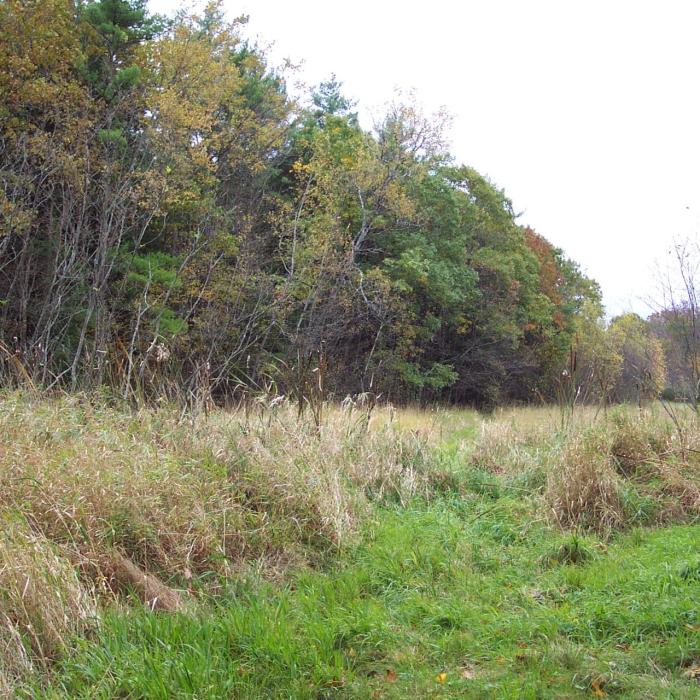About the Property
Nestled within a network of conservation lands that protect the Great Bay watershed, the Dame Forest contains a mix of wetland and upland habitats, including beaver marshes, seeps, vernal pools, and Appalachian oak–sugar maple forests. Areas surrounding Crommet Creek are excellent spots for viewing waterfowl, turtles, and amphibians. The Dame Forest is easily accessible via the northerly start of the Sweet Trail (named in honor of Cy and Bobbie Sweet), a 4-mile trail that winds through the Dame Forest and crosses other conserved lands before finishing on the shore of Great Bay.
Visitor Use Guidelines
Please see our Visitor Use Guidelines page for a complete list of rules and regulations for Forest Society reservations.
Try an Outing on the Forest Society's Mobile App, Powered by OuterSpatial

Visitors to Forest Society reservations can now access information about land and trail maps easily from their mobile devices. Using the OuterSpatial platform, the Forest Society's mobile application is free and available for both iPhone and Android devices. Dame Forest Outing: This interpretive outing provides interesting information about the natural and cultural history of the area you are hiking through on the Sweet Trail.
Property Details
Dame Forest was owned by the same family since the 1840s and was originally part of the Dame Farm. The stone piles within the property and stone walls along the bounds suggest that the land was cleared and used for pastureland. From the hill at the center of the property, livestock most likely looked out over the Great Bay as they grazed. The farm was abandoned the 1950s and returned to the forest we see today. In the mid 1960s, beaver moved in, creating dramatic wetland habitat that includes stretches of open water. The Dame Forest is part of the larger Great Bay estuary watershed, which is recognized as an estuarine ecosystem of state and national significance.
Circumstances of acquisition:
In the mid 1990s the Dame Forest section of Dame Farm was subdivided from the homestead, owned briefly by another landowner, and soon purchased by The Nature Conservancy (TNC) as part of the Great Bay Resource Protection Partnership (GBRPP) project. The GBRPP had targeted the Dame Forest for conservation because of its connections to existing conserved land and its frontage on Crommet Creek, which feeds into Great Bay.
As part of the partnership, The Nature Conservancy (TNC) purchased the property in 1997 using funding from the North American Wetland Conservation Act. A conservation easement was granted to the US Fish and Wildlife Service at the same time. In December of 2003 TNC transferred the property to the Forest Society.
This property features diverse habitat for wildlife as well as an established trail network that creates opportunities for the many people living near the estuary to remain connected to the land.
The Dame Forest was one of the very first acquisitions of the GBRPP, which today has protected more than 5,000 acres of important wildlife habitat, productive farm and forest land, and recreational opportunities in the Great Bay area.The Forest Society is one of the principal partners along with The Nature Conservancy (which acts on behalf of the Partnership as its land and fiscal agent), New Hampshire Fish and Game Department, NH Audubon, Natural Resources Conservation Service, US Environmental Protection Agency, Ducks Unlimited, US Fish and Wildlife Service, and Great Bay Estuarine Research Reserve.
Trail Information
The Sweet Trail
White Diamonds with GBRPP Logo
The Cy and Bobbie Sweet Trail is a hiking and nature exploration trail which winds for four miles between Longmarsh Road in Durham all the way to Great Bay. An excellent interpretive brochure has been created for this trail. The trail is marked with white diamonds that have the Great Bay Resource Protection Partnership logo on them. The Sweet Trail passes along the Dame Forest main trail, from which several short spur trails lead off that provide views of wetland habitats.
There are hiking trails on the Dame Forest, but no other recreational infrastructure (kiosk or parking area) directly at the forest. However, there are parking areas for the Sweet Trail – a portion of which runs through the Dame Forest – on Dame Road and Longmarsh Road. It is at least a 1/3 mile hike to the Dame Forest from Longmarsh Road, the closest of these parking areas.
NOTE: The Forest Society does not plow or guarantee access to this property or its parking areas during the winter.



